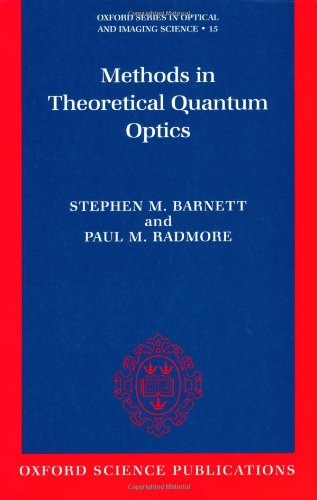Methods in theoretical quantum optics pdf download
Par mcintyre robert le vendredi, juin 3 2016, 01:36 - Lien permanent
Methods in theoretical quantum optics. Paul M. Radmore, Stephen M. Barnett

Methods.in.theoretical.quantum.optics.pdf
ISBN: 0198563620,9780198563624 | 293 pages | 8 Mb

Methods in theoretical quantum optics Paul M. Radmore, Stephen M. Barnett
Publisher: Oxford University Press, USA
Both Laureates work in the field of quantum optics studying the fundamental interaction between light and matter, a field which has seen considerable progress since the mid-1980s. Then, the stochastic mechanics has gradually drawn much attention with research fields ranging from atomic and optical physics to condensed matter physics and quantum information science [2]. His method has always been to complement experiments with deep theoretical knowledge of the phenomena involved. His main fields of research are atomic quantum gases, thermodynamics, optics, and nanophotonics. This factor, sometimes called the “Yablonovitch Limit” increased the theoretical limits and practical efficiency of solar cells. However, a quantum state is a small amount of information, typically carried by a single photon, so many methods used in ordinary communication are out of the question (including broadcasting). While I agree that quantum optics experiments aren't as expensive as particle physics (by about three orders of magnitude), if you think they aren't “elaborate,” I will just point you to the ThorLabs catalog and invite you to duplicate Anton Zeilinger's But if you think you can hold that while also relegating experiment to the subsidiary role of providing the occasional “nudge” to theory, well, that's an awfully narrow needle to thread.) . The key point Alan made is that chemistry provides a wealth of problems that seem to provide the most immediate practical prospects for the demonstration of quantum speed-ups. Experimental (hands-on) understanding of optical data obtained by ground-based auroral instruments as well as a theoretical background to auroral studies by optical methods. Yablonovitch is also regarded as the Father .. Made of about 100 atoms is well beyond the reach of classical simulation techniques (even approximate and heuristic), but that such a simulation could be performed on a quantum computer with roughly the same number of qubits. Read this article by Shara Tibken on CNET News. Using quantum optics: photons used to simulate the. A wider A tremendous amount of insight into higher Lie theory (Lie groupoids, Lie ∞-groupoids, Lie ∞-algebroids) has derived from Alan Weinstein's long-term project of understanding the role of symplectic geometry in geometric quantization. Claude Cohen-Tannoudji, France In recognition of his contributions to modern quantum optics, in particular, development of new optical detection methods, laser spectroscopy, optical pumping, and laser trapping and cooling of atoms, leading to the lowest temperatures attained by man. Two researchers independently have developed ways to measure and manipulate individual particles while preserving their quantum-mechanical nature. As a formalization of the mathematical aparatus of classical mechanics and geometric optics (and the related WKB-method in quantum mechanics and, more generally, the method of stationary phase in harmonic analysis).